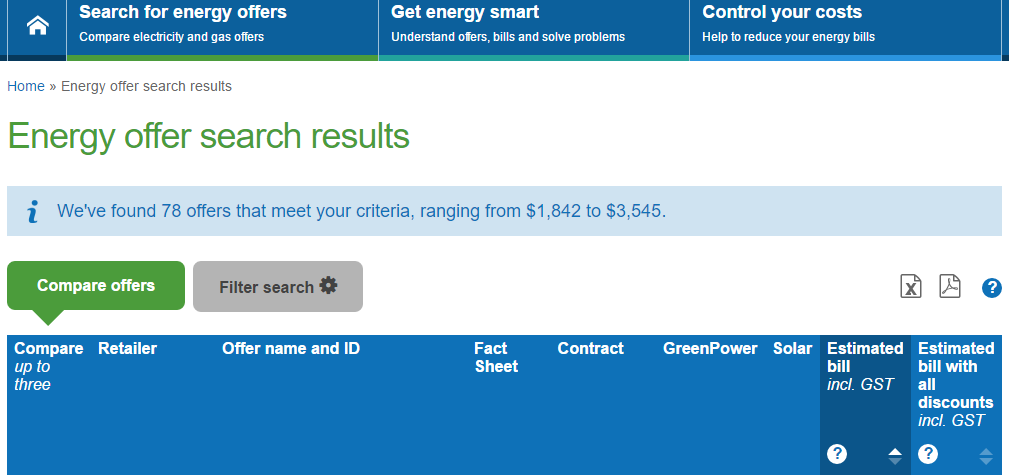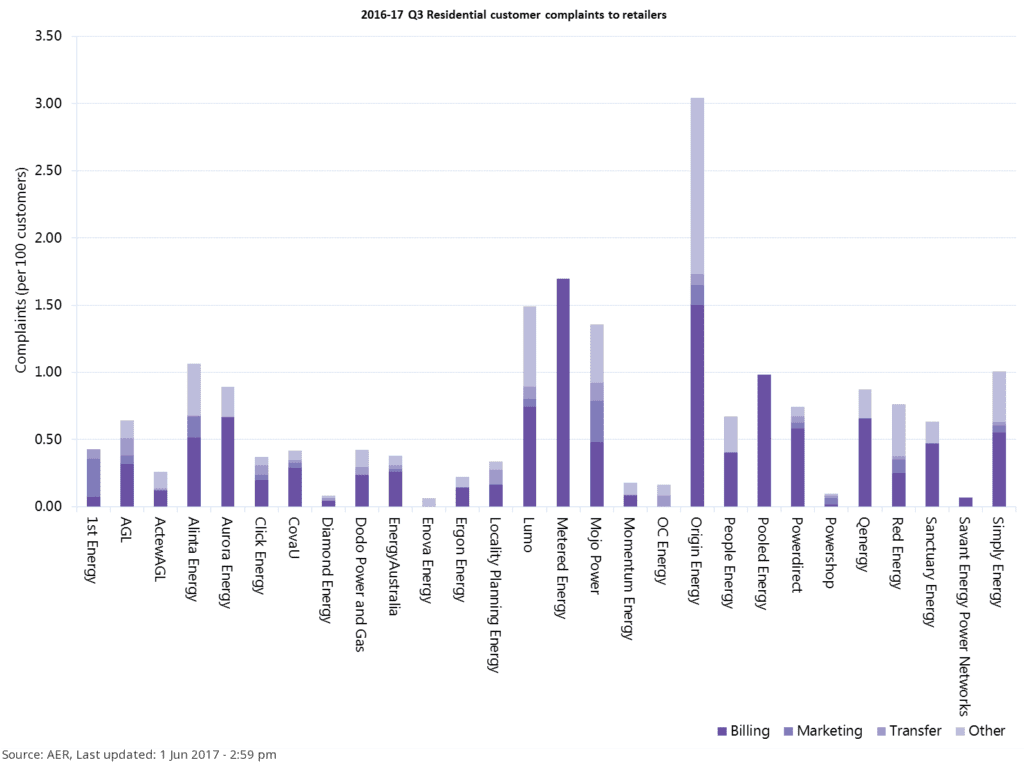When solar system owners shop around for an electricity retailer, the first thing they tend to look at is the solar feed-in tariff rate that the retailer offers. The fact is, however, that solar feed-in tariffs are no longer as important as they once were – so what else should solar system owners look for in an electricity retailer?
(N.b. The comments in this article may not apply to households on legacy solar feed-in tariffs, which offer much higher rates for exported solar energy. These programs, which are state-backed, have all closed to new applicants. This article is written mainly with ‘new’ solar households in mind – homes who have or are thinking about getting solar, but who do not have access to a generous feed-in tariff.)
Our solar, for ourselves
These days, solar power is affordable, but solar feed-in tariffs are relatively low, at around 10-15c/kWh of exported solar energy depending on where you live and who your retailer is. The upshot of this is that solar homes are wise to keep their solar energy to themselves, as doing so maximises savings in a way that is not possible by sending energy into the grid. (The exception is for homes with batteries, who may be able to occasionally export stored energy during high-price events, as with Diamond Energy/Reposit Power’s GridCredits100 program.)
Compare solar quotes from up to 7 local installers now.
Does a higher FiT actually translate into smaller bills?
It’s also useful to keep in mind that as a rule of thumb, if your retailer is giving you a higher feed-in tariff, you’re probably paying for it in other aspects of your bill – for example, a higher daily supply charge or higher c/kWh usage rates. In a competitive market, higher feed-in rates are more often than not a ‘lure’ for attracting solar customers, and may not ultimately make any difference in terms of the amount of your energy bills; in fact, you may even end up paying more in the long-run.
Why do electricity retailers offer different prices?
The retail electricity business is a highly competitive and commodified one – some might even call it cutthroat. There is no discernible difference in the quality of the essential service that different energy retailer provide – even if your electricity retailer disappeared tomorrow, you would still have electricity available on demand, at the flip of a switch.
Despite this fact, retailers offer different packages with different rates. Many retailers offer packages that are very close on estimated annual cost (check out www.EnergyMadeEasy.gov.au to get free comparisons & summaries), but which may differ in the particulars of how you are charged for what.

A screenshot from the EnergyMadeEasy.gov.au website, which is a great place to start shopping for a retailer.
Before you sign up for a plan, have a careful look at the energy price fact sheets from the retailers you are considering. Additionally, keep in mind that the ‘estimated bill’ summaries that the EnergyMadeEasy website provides are also a useful reference, but they may not take into account the exact way that you use energy or consume power from your solar PV system throughout the day.
The different levers that electricity retailers can pull to create differences in their products based on price are listed below:
- Daily supply charge – the amount you pay to be connected to the grid, regardless of how much energy you end up drawing from it.
- Usage/consumption charges (cents per kilowatt-hour, c/kWh)
- For flat-rate plans, this c/kWh is always the same, barring periodic changes (which your retailer is required to notify you about).
- For time of use (TOU) plans, this rate is higher during evening and weekends and lower in the wee hours of the morning – the differential between these ‘peak’, ‘off-peak’ and ‘shoulder’ rates is another area where retailers can differentiate their plans from one another.
- For block rate plans, the amount you are charged per kWh increases (or sometime decreases) depending on the amount of energy you purchase over the course of a day or quarter – e.g. 25c/kWh for the first 10kWh in a day, and then 27c/kWh thereafter.
- Solar feed-in rate – the amount you are paid per kWh for solar energy that you put into the grid
- Discounts – e.g. pay-on-time, pay online, etc.
- Demand charges – are charges for consuming over a certain amount of power at any given time over the course of the day – e.g. if there are multiple devices all running at once. (For residential customers, demand charges are rare to find except in South Australia; they are commonplace for commercial & industrial customers.)
- Exit fees: Will your electricity retailer whack you with a fee for breaking your contract? Some companies do.
- Subscription fees – some retailers may also charge an additional ‘subscription fee’ which essentially works out to be an additional fixed fee on your bill.
Besides price, how else can retailers stand out?
So what are the other ways in which electricity retailers can make themselves stand out when all most people want is electricity at the flip of a switch – which they can get anywhere? We’ve divided them into two broad categories outlined below: non-technological approaches and technological approaches.
Things that don’t involve technology
Some of the basic, non-technological ways that an electricity retailer can make a case for themselves are:
- Good, local customer service: One way that retailers save money is by outsourcing their service departments. While there may be varying degrees of quality amongst overseas call centres, by and large Australians find it frustrating to be transferred to someone outside the country to resolve issues or get questions answered. And even among the retailers who do keep their service team local, there may be varying degrees of quality. The Australian Energy Regulator publishes complaint data about retailers for most states on a quarterly basis. The most recent data is summed up in the table below (click to enlarge). We also note that the technology platform that the retailer used – enabled through smart meters and energy management systems – can also translate into better customer service, as the retailer will have more insight into the customer’s individual circumstances (see next section).

- Ethical/environmentally friendly: Some electricity retailers are by ‘greener’ than others, and will market themselves as such. Unfortunately, this may come with a bigger price tag – especially if you are paying for Green Power. (EthicalSwitch is a good resource to start a search for a higher-minded electricity retailer.)
- Orientation towards the community: A growing number of local, co-op or not-for-profit retailers are popping up across Australia. (Enova – based in the Northern Rivers region of NSW – is a great example.)
- Solar-friendly: Some retailers (such as Diamond Energy) pride themselves for being especially welcoming to solar customers, with processes in place to help customers not only get connected, but then to help them get the most out of their solar PV systems. Companies that are truly solar-friendly do more than just offer a higher feed-in tariff: they offer a holistically better deal for solar customers than what is available elsewhere.
Things that do involve technology
Retailers may also offer technology to improve the customer experience, although sometimes at a cost (up-front or embedded into bills). Some examples include:
- Offer smart meters & give customers on-demand, digital access to the state of their bill: Smart meters can deliver substantial value to you as a customer – provided your retailer is willing to unlock that value for you. This usuall takes the form of a smart pone app or web portal, and helps to avert customer ‘bill shock’ before it happens by alerting customers when their usage is unusually high, or if they’re on track for a higher-than-usual bill.
- Offer an energy management system: An energy management system (EMS) allows the customer to monitor and control some aspect of the energy flows within their home. On a basic level, most ‘pure’ EMSs will work within a home without solar or batteries, providing alerts about appliances that could be turned off/on to save money, as well as the ability for the user to control them (either through automation or manually). However, a good EMS should also help to improve the value that solar & batteries deliver if they are present. In the best case scenario, if offered by an electricity retailer, an EMS will do all of these things, as well as integrate into your retailer’s billing system. Properly implemented, an EMS can help deliver an experience that exceeds any expectations that a customer would ordinarily have of their electricity retailer.
- Offer peer to peer (P2P) energy trading: This is the ability to sell excess (exported) solar or stored battery energy to other households – usually (but not always) to the overall benefit of both the buyer and the seller. For P2P trading to be possible, a ‘moderator’ is usually necessary – and an electricity retailer is well positioned to be that moderator. (Localvolts is a Sydney-based startup aiming to establish a ‘pure’ peer-to-peer exchange platform, but they are still in their incubation phase.)
- Demand response or spot market response: The wholesale electricity market is prone to high price spikes as well as low dips.
- Electricity retailers can further their own interests as well as yours by controlling devices in your home (such as air conditioners or refrigerators) to use less electricity at times when the wholesale electricity price or network demand is high – called demand response.
- They may also reward you for exporting energy to the grid when electricity demand (and spot market prices) are high – which here we’ll refer to as ‘spot market response’. Currently, technology company Reposit Power have paired up with several retailers (including Diamond Energy and PowerShop) to make this possible with battery storage, but the one company that offered open access to the spot price for solar system owners (Urth Energy) went into administration.
Do you need a retailer to get the technology? No
Although retailers are in a perfect position to deliver optimum value to their customers by pairing their insights about your consumption habits with suitable technology, you can also source and purchase most of these technologies (yes, even smart meters) yourself. Make sure you shop around so that you know what you’re actually getting – a good place to start is our article comparing home energy management systems.
 In summary: Feed-in tariffs are just one piece of the puzzle
In summary: Feed-in tariffs are just one piece of the puzzle
In this article we’ve attempted to lay out the many factors besides solar feed-in rates that may distinguish energy retailers and their offerings from one another – and there are plenty of them. We wholeheartedly recommend the EnergyMadeEasy.gov.au website as a starting point for an impartial look at all of your options.
Compare electricity plans (including feed-in tariffs) :
Other useful resources:
Try our Simple Solar PV Payback Estimator Tool
Learn about battery storage: Check out our Battery Storage 101 page
Try our Solar & Battery Storage Sizing & Payback Estimator Tool
Check out our Battery Storage Product Performance Comparison Tool
See the rest of our calculators in our Calculator Resource Library
© 2018 Solar Choice Pty Ltd
- Solar Power Wagga Wagga, NSW – Compare outputs, returns and installers - 13 March, 2025
- Monocrystalline vs Polycrystalline Solar Panels: Busting Myths - 11 November, 2024
- Solar Hot Water System: Everything You Need to Know - 27 February, 2024
Hi James, great article. You reference P2P sharing of energy as a way of getting a better price on solar energy exported to the grid and sold via a moderator. Is this service active in Australia and if so, how do I find out about it. Cheers Anthony
Hi Anthony,
Thanks for the comment. I’ve actually gone and updated the bit about P2P trading with a link to our article about Localvolts. Localvolts is developing this sort of P2P trading platform (the only one we’re aware of, in fact) but it is not yet commercially available in Australia. We look forward to when it comes online!